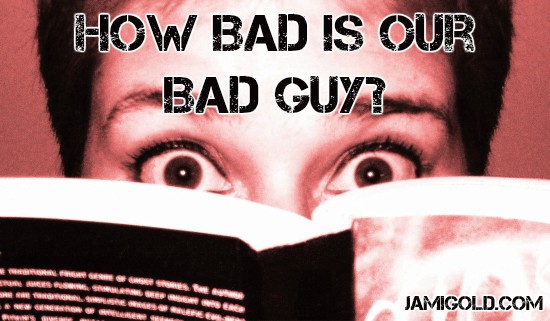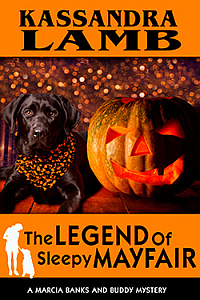How Do We Create Realistic Villains? — Guest: Kassandra Lamb

Every story requires an antagonist—or at least an antagonistic force—that creates situations and/or circumstances that force the protagonist to take action. Without a conflict from the antagonist, there’s no story, as our protagonist would have no reason to grow or change themselves or to try to change the world or their situation.
In other words, antagonists drive the story.
But while we definitely need some type of antagonist, we get to determine what kind of antagonist they are. The antagonist in our story might be a force of nature, a love interest, or a meddling best friend. Or they might be a true villain trying to harm others, an uncaring psychopath/sociopath, or fully evil in every respect.
There’s no right or wrong answer—only what makes sense for our story. And for some stories, we need a villain who does evil things. Which might prompt several questions for us to address next: How bad are they? Why do they do evil things? How can we write evil if we can’t understand it?
Kassandra Lamb, a retired psychotherapist, is here with Part One of a post to help us develop those bad guys (and girls) in our stories. Today, she’s teaching us about our options for our villains, including psychopaths and sociopaths—what they are, what they do, and where they come from. Next week, she’ll be back with some do’s and don’ts in Part Two.
Please welcome Kassandra Lamb! *smile*
*****
Psychopaths, Sociopaths and Other Bad Guys and Gals, Part 1
by Kassandra Lamb
One of the toughest tasks we authors face is deciding how to portray our bad guys and gals. Will we make them out to be misguided and conflicted souls, or totally evil psychopaths, or somewhere in between? And exactly what is a psychopath anyway?
This question came up for me recently as I finished up a Halloween story in my cozy mystery series. I was tempted to go the conflicted soul route and have my antagonist be at least partially redeemed at the end, but some of the things this antagonist was destined to do, it would take a full-blown psychopath to go there. So that’s the direction I had to take.
Sometimes, like in this case, the plot dictates how evil and lacking in remorse the antagonist must be, but other times, most times really, we may want to have at least some positive traits in our bad guys.
So how to do that and still be true to human nature? (As it really is, not how it is portrayed all too often in movies and TV shows.)
Let’s Start with Some Terms…
First, let me clarify our terminology. Sociopath and psychopath are essentially the same thing. They are two different words, coined at different points in the history of the mental health field, but referring to the same people … and neither is still officially used in the field today.
The official terminology is now antisocial personality disorder (ASPD), and members of the mental health field will rarely use the terms sociopath or psychopath in any official capacity.
But saying “a person with antisocial personality disorder” is a bit cumbersome, so mental health professionals, especially in conversations with lay people, may unofficially use the word psychopath.
I will come back to the concept of sociopath in a bit.
What Is a Psychopath?
So again, what is a psychopath exactly, i.e., someone with ASPD? They are noted for several personality traits, the most troublesome being a lack of remorse and inability to feel empathy for others.
Need a villain in your story? @KassandraLamb helps us determine how bad they should be: misguided or a psychopath? Click To TweetThey engage in antisocial behaviors, such as aggression, stealing, lying, etc., with no concern for who they are harming. Indeed, they often get off on the sense of power that harming others gives them. They also tend to be thrill-seeking and impulsive.
They have a very high threshold for stimulation, a fancy way of saying that it takes a lot to make them feel anything. So normal life, that would make most of us quite happy, feels incredibly boring to them. Thus the thrill-seeking. Also, their high threshold for stimulation keeps them from feeling fear in situations that most of us would find quite scary (like being arrested).
This means they will do some pretty outrageous things, either ignoring or rationalizing away the potential negative consequences for themselves. The really smart ones, however, may meticulously plan out their evil deeds, but this lack of fear can often be their downfall.
Antisocial Personality Disorder is caused by a combination of genetics and a harsh, abusive environment growing up. More on this in a moment.
Other Bad Guys and Gals
Sometimes we will want our antagonists to be basically good people who find themselves in bad situations.
- Maybe something pointed them down the wrong road—an event where they did something bad accidentally, or in self defense, and are now tortured by guilt about it.
- Maybe something extremely important to them is at risk and therefore they are willing to violate their moral code in order to protect it.
In one of my mysteries, the “who” in the whodunnit is middle-aged and has never done violence to anyone before. But he has a dependent personality and when the person on whom he is dependent is threatened with jail, the antagonist feels that he needs to kill certain people in order to preserve that relationship.
These bad guys and gals will feel guilt regarding their behavior, but they will push it aside as best they can and/or rationalize it, sometimes via displaced anger. If they have to hurt someone in order to protect what is important to them, they may blame their victim. “If you hadn’t done such and such, I wouldn’t have to do this!”
These folks may conceivably be talked down from whatever violent approach they had been about to pursue, and they are likely to feel considerable remorse.
Somewhere In Between: Narcissists
Somewhere in between the average folks who’ve gotten into a bad situation and the psychopaths are the narcissists.
Self-centeredness is a trait shared by psychopaths and narcissists. For both of these groups, it’s all about them, and narcissists are often also braggarts. They exaggerate their accomplishments and boast about their attributes.
Most, if not all, psychopaths are also narcissists, but it doesn’t go in the other direction—most narcissists are not psychopaths. The traits that differentiate the two groups are the ability to feel remorse, empathy, and fear.
What's the difference between a psychopath, sociopath, and a narcissist? @KassandraLamb shares her insights... Click To TweetNarcissists come across as being full of themselves, but they are actually full of self doubt. They are insecure and expend a lot of energy trying to prove themselves to others and to themselves.
But if something shocks them out of their self-absorption long enough, they can feel empathy for others and remorse for their own behaviors. And their fear of repercussions is about the same as most people’s. Maybe even higher than average, because of their fear of being seen in a negative light by others.
Consequences that might befall other people they can more easily rationalize away, especially if those people are distant from them, not someone they know or care about personally.
Somewhere In Between: Sociopaths
The concept of a sociopath was first introduced in 1909 by a German psychiatrist, Karl Birnbaum, who did not believe that antisocial behavior stemmed primarily from “constitutional flaws,” the prevailing belief of that day (and today). Rather he felt that it was more due to socialization.
Some mental health professionals still like to make that distinction, sometimes using sociopath to describe people with ASPD who are not genetically predisposed nor totally lacking in remorse or empathy, but rather they have been strongly influenced by an environment where antisocial behaviors are normalized.
In other words, the father is a psychopathic member of the Mafia or a drug cartel but the son missed getting those psychopath genes. Nonetheless, he grows up in an environment where taking advantage of others to make money and killing one’s competitors is normal.
Or a young person with normal genetic makeup lives in a neighborhood where, in order to survive, one must join the local gang. And in that gang environment, it is acceptable and even desirable to do things that the rest of society abhors.
So this person does bad things, even hurts people, but they do have a conscience, although it may be weak. They have to expend a certain amount of emotional energy keeping the guilt at bay.
Ironically, this guilt may come out as anger at the person whom they perceive as “making them feel guilty.”
They may also have limits past which they will not go, certain restrictions on what they will or will not do, such as not hurting children or animals.
Also, keep in mind that all of these personality disorders exist on a continuum.
So within a street gang, for example, there will likely be several full-blown psychopaths—one will most likely be the gang’s leader. Others may not be at that extreme end of the continuum; they may experience some remorse and empathy, which they attempt to suppress—maybe even think of as signs of weakness—in order to get along in the gang environment. And then there will possibly be one or two dependent personalities, people so insecure that they will do things they know are wrong in order to maintain the contact with the leader and/or group on which they depend for emotional (and perhaps physical) survival.
Backstory and Underlying Dynamics
Lots of research has established that there is some genetic predisposition involved in antisocial behavior. That predisposition usually needs some pretty bad environmental circumstances, however, in order to produce a full-blown psychopath.
The high threshold for stimulation, mentioned above, is one of the things that is inherited. But scans of psychopaths’ brains also show differences in how they are wired. And genetically-transmitted learning disorders are almost always part of the picture as well. (See our topic page on The Making of A Psychopath over at the misterio press site for more details on the causes behind ASPD.)
Also, the balance between the genetic and environmental factors varies from one person to another. A strong genetic predisposition may only need inconsistent, occasionally harsh parenting to bring it to fruition, while a milder predisposition combined with an extremely abusive environment may also result in an antisocial personality.
While psychopaths often have experienced severe physical abuse as children, narcissists are more likely to have suffered from verbal and emotional abuse. Constantly being told that they are useless, a loser, and never good enough is often combined with some area where they do shine and for which they are praised, at least in public. Or someone else in the household may have excelled in some way and received the bulk of the family’s adoration.
The child learns that the only way to be good enough is to be great at something. Thus the grandiosity masking self doubt, and the insatiable need to prove themselves.
For More Information…
Hopefully this has given some guidance in how to realistically set up and portray antagonists that fall into one of these personality types.
Next week I’ll be going into more detail about some do’s and don’ts when developing psychopaths and narcissists as our bad guys and gals.
Sources:
- Sociopath vs. Psychopath: What’s the Difference? – WebMD
- Psychopathy–Scholarpedia
- Narcissist, Psychopath, or Sociopath: How to Spot the Differences (I don’t completely agree with everything this woman says, but her descriptions are good.)
*****
 Kassandra Lamb is a retired psychotherapist and trauma recovery specialist who now indulges her love of writing mysteries. She pens everything from cozy mysteries (her latest release, The Legend of Sleepy Mayfair) to edgy romantic suspense under the pen name Jessica Dale (Jessica’s new release, Binding Vows).
Kassandra Lamb is a retired psychotherapist and trauma recovery specialist who now indulges her love of writing mysteries. She pens everything from cozy mysteries (her latest release, The Legend of Sleepy Mayfair) to edgy romantic suspense under the pen name Jessica Dale (Jessica’s new release, Binding Vows).
Website | Facebook | Pinterest | Goodreads | Twitter | Amazon | Jessica Dale Website
*****
 The Legend of Sleepy Mayfair, A Marcia Banks and Buddy Cozy Mystery:
The Legend of Sleepy Mayfair, A Marcia Banks and Buddy Cozy Mystery:
A Halloween romp that turns seriously scary!
Her adopted town is once again driving service dog trainer Marcia Banks a little nuts. The octogenarian, muumuu-wearing town matriarch wants to turn the new riding stable into a haunted house, a vandal is disrupting Mayfair’s small-town tranquility, and as Halloween approaches, an even darker evil lurks in the shadows.
Amazon | Kobo | Nook | Apple | GooglePlay
 Binding Vows, A Binding Love Romantic Suspense
Binding Vows, A Binding Love Romantic Suspense
(by my alter ego, Jessica Dale)
Prudence Parker seems like a got-it-all-together young woman, but she has her share of personal demons—from hating her name to trying to control the “beast” inside her who tends to pick lousy, and sometimes dangerous, romantic partners.
Discovering she’s pregnant by an abusive ex-fiancé solves one issue, a particularly pushy biological clock. But then the s.o.b. files for custody. And despite an in-name-only marriage to her platonic best friend, her ex persists. Why is this man so obsessed with fatherhood, to the point where he will do anything? Even frame her for murder…or worse.
WARNING: This book contains some graphic scenes that may be triggering.
*****
Thank you, Kassandra! As someone outside the field of psychology, I’d vaguely heard that sociopath and psychopath weren’t “official” terms, but it’s good to learn the details behind that hazy impression. *grin*
I really like the distinctions Kassandra points out between different types of bad guys:
- Some are good people who do bad things for good reasons.
- Some could be good people but have learned to do bad because of their environment.
- Some don’t care or have any remorse.
But as Kassandra says, even a psychopath wouldn’t necessarily turn out to be a villain unless their environment was a problem as well. Her insights reminded me of an article I read years ago about a scientist who accidentally discovered he had a psychopathic brain, but his loving, nurturing environment kept him from turning violent or evil.
When we’re making our bad guys, we could easily fall back on cliché. Luckily, Kassandra’s insights can help us recognize and understand the different layers we might find along the “bad guy” spectrum. With that understanding, hopefully we can avoid creating one-note, mustache-twirling villains. *smile*
What type of antagonists have you written? Have you written any villains closer to the evil side of the spectrum? Did you struggle to ensure they weren’t cliché? Does this post help explain our options? Do you have any questions for Kassandra?
Pin It
Cool stuff, Kass! I’d always wondered about these distinctions. Love how you framed it in terms of writing our villains – thanks!
Thanks, K.B. Glad you found the info helpful.
Thanks so much, Jami, for letting me hang out in your cyber living room today. I’ll stick around for a bit, in case there are questions. 🙂
Hi Kass,
I love your insights so much — thank YOU for sharing them! 😀
Thanks! Interesting material.
You’re welcome. Hope you find it useful, Clare.
Cool! I had believed that sociopaths are “smarter”, able to make meticulous, organized plans for their deeds; while psychopaths are more impulsive and not as ingenious. Looks like I got it mixed up.
Glad I could clarify, Sieran. Sometimes I wish there was a way to erase a word from the language. The existence of these two fairly interchangeable words is downright confusing.
This is a good post with a lot of helpful information. Thanks, Kass. 🙂 — Suzanne
You’re very welcome! Glad you found it so helpful.